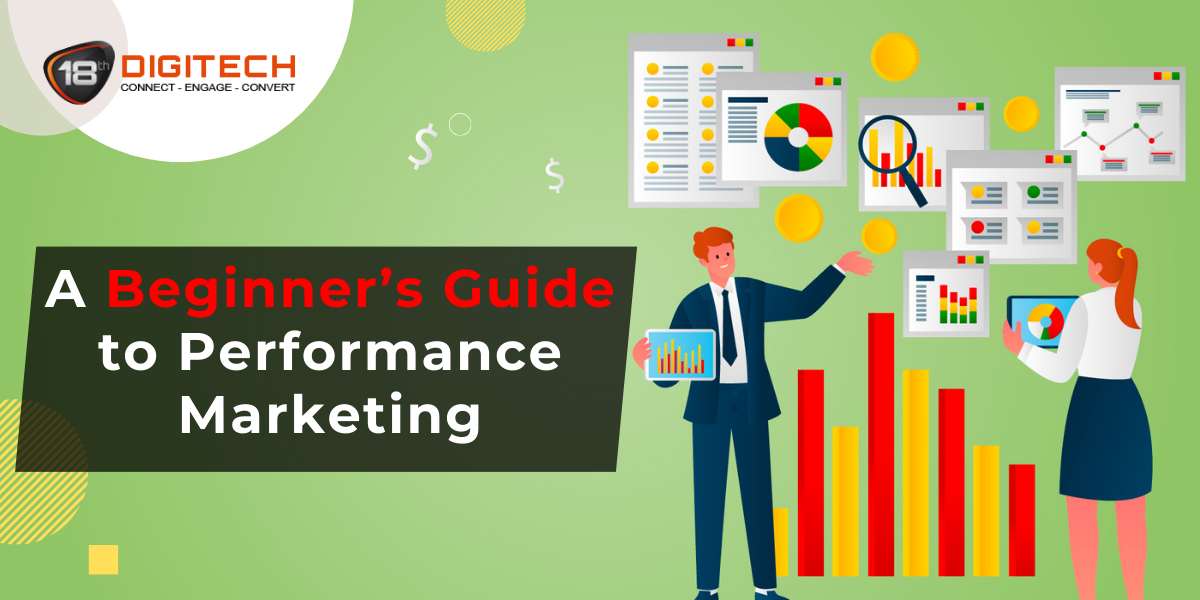In the ever-evolving digital marketing landscape, performance marketing has emerged as a dynamic and results-oriented strategy. Unlike traditional marketing approaches focused on brand building, performance marketing centers on quantifiable outcomes and return on investment (ROI). This data-driven methodology leverages various online channels to drive specific actions, such as clicks, leads, or sales. By emphasizing measurable results, businesses can allocate resources efficiently, ensuring that marketing efforts directly contribute to their objectives. Performance marketing thrives in the digital realm, utilizing platforms like Google Ads, social media, and affiliate partnerships to reach target audiences effectively. With its emphasis on accountability and tangible results, performance marketing has become an indispensable tool for businesses seeking to navigate and succeed in the complex digital marketing ecosystem.
This comprehensive guide aims to provide beginners with a solid understanding of performance marketing and its key components, including ecommerce, affiliate marketing, paid search marketing, and search engine marketing.
Let’s get started!
Defining Performance Marketing
Performance marketing is a data-driven marketing strategy that focuses on quantifiable and measurable outcomes. Unlike traditional marketing approaches that prioritize brand awareness, performance marketing is all about driving specific actions and achieving a tangible return on investment (ROI). This method employs various digital channels and advertising platforms to reach target audiences with precision, aiming to generate desired actions such as clicks, leads, or sales. The success of performance marketing campaigns is evaluated through key performance indicators (KPIs), allowing businesses to assess the effectiveness of their strategies and optimize them for optimal results. This results-oriented approach ensures that marketing efforts are directly tied to the achievement of specific business objectives, making performance marketing an essential and highly adaptable component in the contemporary marketing landscape.
Key Components of Performance Marketing
Performance marketing is a multifaceted strategy that encompasses several key components. Each component plays a crucial role in achieving measurable results and driving specific actions.
- Search Engine Marketing (SEM): SEM involves both paid and organic strategies to enhance a website’s visibility on search engine results pages (SERPs). Paid search, such as Google Ads, allows advertisers to bid on keywords and display targeted ads to users actively searching for related products or services.
- Paid Search Marketing: Paid search marketing is a subset of SEM where advertisers bid on keywords to display ads on search engine results pages. This pay-per-click (PPC) model ensures that businesses only pay for actual clicks, making it a cost-effective way to reach potential customers.
- Affiliate Marketing: Affiliate marketing is a performance-based model where businesses collaborate with affiliates (publishers or influencers) to promote their products or services. Affiliates earn a commission for each sale, click, or lead generated through their unique affiliate link, providing a mutually beneficial arrangement.
- eCommerce Optimization: eCommerce optimization involves leveraging performance marketing strategies to drive sales and revenue for online businesses. This includes optimizing product pages, utilizing targeted advertisements, and employing techniques to enhance the overall online shopping experience.
- Social Media Advertising: Social media platforms offer powerful tools for performance marketing. Advertisers can create targeted ads based on user demographics, interests, and behavior. Social media advertising allows businesses to reach a specific audience, drive engagement, and achieve desired actions.
- Content Marketing: Content marketing is an integral part of performance marketing, focusing on creating valuable and relevant content to attract and engage the target audience. Content can be optimized to drive specific actions, such as clicking on a link, signing up for a newsletter, or making a purchase.
- Email Marketing: Email marketing is a direct and cost-effective channel within performance marketing. By sending personalized and targeted messages to a segmented audience, businesses can nurture leads, encourage customer retention, and drive conversions.
- Data Analytics and Measurement: Data analytics and measurement are fundamental to performance marketing. Businesses rely on key performance indicators (KPIs) to assess the success of campaigns, track user behavior, and make data-driven decisions. Continuous analysis and optimization based on performance data are essential for ongoing success.
- Conversion Rate Optimization (CRO): CRO focuses on optimizing website elements to improve the likelihood of converting visitors into customers. This involves A/B testing, user experience improvements, and other strategies to enhance the overall conversion process.
- Retargeting and Remarketing: Retargeting and remarketing involve showing targeted ads to users who have previously interacted with a website or abandoned a shopping cart. This tactic aims to re-engage potential customers and encourage them to complete desired actions.
Advantages of Performance Marketing
Performance marketing offers a range of advantages for businesses seeking measurable and targeted results in their marketing efforts.
Here are some key advantages:
- Measurable Results: One of the primary advantages of performance marketing is its focus on measurable outcomes. Through key performance indicators (KPIs) such as clicks, conversions, and return on investment (ROI), businesses can precisely measure the success of their campaigns.
- Cost-Effectiveness: Performance marketing operates on a pay-for-performance model, where advertisers only pay for actual results, such as clicks or conversions. This ensures efficient allocation of marketing budgets, maximizing cost-effectiveness.
- Targeted Advertising: Performance marketing allows businesses to target specific demographics, interests, and behaviors. This targeted approach ensures that advertisements reach the most relevant audience, increasing the likelihood of conversion.
- Flexibility and Adaptability: Performance marketing campaigns are highly flexible and adaptable. Advertisers can adjust strategies in real-time based on performance data, market trends, and consumer behavior, allowing for quick optimization and responsiveness.
- Improved ROI: With a focus on measurable results and cost-effectiveness, performance marketing typically leads to a higher return on investment. Advertisers can refine and optimize campaigns based on data analysis; ensuring resources are allocated where they generate the most value.
- Data-Driven Decision Making: Performance marketing relies heavily on data analytics. This data-driven approach allows businesses to make informed decisions, understand customer behavior, and continuously refine strategies for better performance.
- Enhanced Target Audience Reach: Through various channels such as social media, search engines, and affiliate partnerships, performance marketing enables businesses to reach a broader yet highly targeted audience. This is particularly advantageous for businesses looking to expand their market reach.
- Transparent Attribution: Performance marketing provides clear attribution models, allowing businesses to understand the journey of a customer from the initial interaction to conversion. This transparency aids in evaluating the effectiveness of each touchpoint in the customer’s path.
- Quick Campaign Deployment: Digital channels used in performance marketing, such as paid search and social media advertising, enable quick campaign deployment. Businesses can rapidly launch and modify campaigns, responding to market changes or capitalizing on timely opportunities.
- Incremental Scaling: As businesses experience success with performance marketing, they can scale their campaigns incrementally. This scalability allows for controlled expansion, ensuring that increased efforts align with positive performance indicators.
- Engagement and Interactivity: Performance marketing often involves interactive and engaging content, enhancing user experience. This can lead to increased brand engagement, customer loyalty, and a higher likelihood of conversion.
- Global Reach: With the digital nature of performance marketing, businesses can extend their reach globally. This is particularly beneficial for ecommerce businesses looking to tap into international markets and diverse consumer segments.
Effective Measures to Implement Performance Marketing
Implementing performance marketing successfully requires a strategic and systematic approach. Here are effective measures to ensure the successful execution of performance marketing initiatives:
- Set Clear Objectives: Begin by defining clear and measurable objectives for your performance marketing campaign. Whether the goal is to increase website traffic, generate leads, or drive sales, having specific objectives will guide your strategy and measurement metrics.
- Identify Target Audience: Understand your target audience’s demographics, interests, and online behavior. Create buyer personas to tailor your marketing messages and choose the most effective channels for reaching your audience.
- Utilize Data Analytics: Leverage data analytics tools to gather insights into user behavior, campaign performance, and other relevant metrics. Regularly analyze this data to make informed decisions, identify trends, and optimize campaigns for better results.
- Implement A/B Testing: Test different elements of your campaigns, such as ad copy, visuals, and calls-to-action, through A/B testing. This iterative process helps identify what resonates best with your audience, allowing for continuous improvement.
- Optimize Landing Pages: Ensure that your landing pages are optimized for conversions. The design, content, and user experience should align with the goals of your campaign. Implement clear calls-to-action and minimize friction in the conversion process.
- Deploy Multi-Channel Campaigns: Diversify your marketing channels to reach a broader audience. Utilize paid search, social media advertising, email marketing, and other relevant channels to maximize your campaign’s exposure and effectiveness.
- Invest in Quality Content: Develop high-quality and relevant content that aligns with your target audience’s interests. Engaging content not only attracts potential customers but also contributes to better SEO, enhancing the overall performance of your marketing efforts.
- Implement Retargeting Strategies: Use retargeting or remarketing techniques to re-engage users who have interacted with your website but did not convert. This helps in nurturing leads and encouraging them to complete desired actions.
- Establish Affiliate Partnerships: If applicable to your business model, consider establishing affiliate partnerships. This can broaden your reach as affiliates promote your products or services, earning a commission for each successful conversion they contribute to.
- Monitor and Adjust in Real-Time: Performance marketing is dynamic, so it’s crucial to monitor campaign performance in real-time. Use analytics tools to track key metrics and make adjustments promptly to capitalize on successful strategies or address issues as they arise.
- Focus on Mobile Optimization: Given the increasing use of mobile devices, ensure that your performance marketing campaigns are optimized for mobile users. Responsive design and mobile-friendly content contribute to a positive user experience and higher conversion rates.
- Budget Allocation and Bid Management: Allocate your budget strategically across different channels based on their performance. Utilize bid management tools to optimize bids for keywords and placements, ensuring efficient spending and maximum ROI.
- Continuous Testing and Iteration: Adopt a mindset of continuous improvement through ongoing testing and iteration. Stay abreast of industry trends, test new strategies, and be willing to adjust your approach based on the evolving landscape of digital marketing.
- Stay Compliant with Regulations: Adhere to data protection and privacy regulations, such as GDPR or CCPA, to build trust with your audience. Ensure that your marketing practices comply with legal and ethical standards.
- Measure ROI and KPIs: Regularly assess the return on investment (ROI) and key performance indicators (KPIs) relevant to your objectives. This information provides valuable insights into the success of your performance marketing efforts and guides future decision-making.
Wrapping Up,
As businesses continue to navigate the dynamic digital landscape, understanding and implementing performance marketing strategies is essential for sustainable growth. By embracing ecommerce, affiliate marketing, paid search marketing, search engine marketing, and the broader spectrum of digital marketing, beginners can lay a solid foundation for success. The key lies in adopting a data-driven approach, continuously analyzing performance metrics, and optimizing campaigns for maximum impact. With this beginner’s guide, you are now equipped with the knowledge to embark on your performance marketing journey and drive tangible results for your business.
If you are looking to implement performance marketing for your business, contact an expert at 18th DigiTech today!












